Castles and palaces in Spain tell the story of the country’s history. Spain has a long history of conquests, empires, and civilization, with each empire leaving its mark on the geographical landscape of the country. There exist countless historical landmarks in Spain symbolic of the rich cultural heritages that the country shares. Most of the cultural and historical heritage of the country is in perfectly preserved form, which attracts thousands of tourists across the globe to revel in the historical glory of the country.
Guest writer, Elora Holt takes us on a historical romp through the great castles and palaces of Spain.
If you are a history fanatic who also enjoys aesthetically pleasing sights, especially the wonderful castles and palaces in Spain, the country’s architecture can offer you both. This article features five of the most appealing and intriguing historical architectural gems that you can enjoy while visiting Spain.
Alhambra Palace in Granada
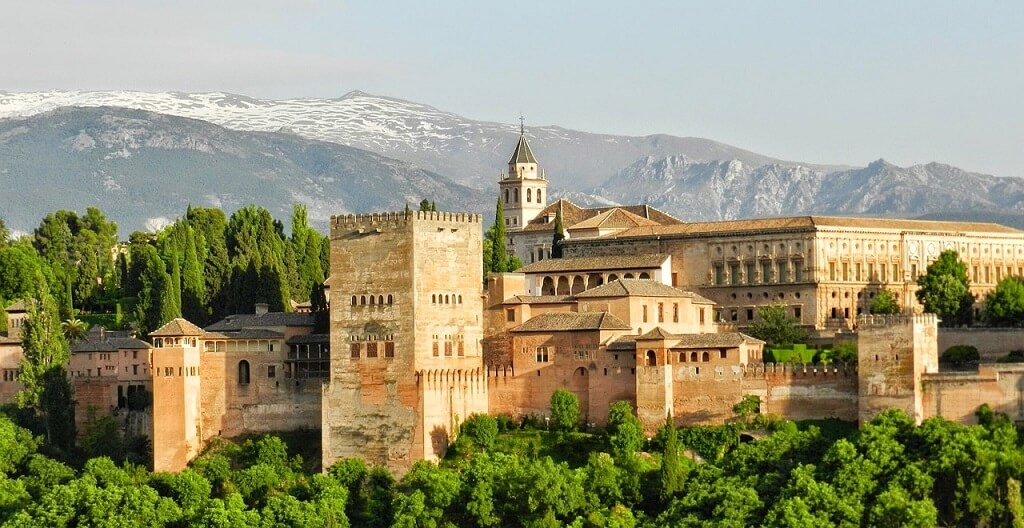
History of Alhambra Palace
Located in Granada, Spain, the ancient palace of Alhambra stands proud with its reddish walls and large towers surrounding the citadel. Alhambra Palace had its origin in the ninth century under Moorish rule. The palace began as a small fortress known as Alcazaba. The fortress was expanded and built out as a military base for the Sultan under Nasrid rule, a Muslim dynasty that lasted over 250 years until the Spanish conquest of 1492. It is perhaps the best known of the palaces in Spain.
The expansion was followed by the designation of Alhambra Palace as the royal residence and court of Granada in the 13th century. For the coming three centuries, the palace continuously underwent reinforcements and reconstructions, including the strengthening of the castle walls, an increase in the number of defensive towers followed by the expansion of royal guard barracks, and the building of orchards and gardens around the palace. Following the conquest of Granada in 1492, the Catholic rule over Alhambra Palace continued to reinforce the palace structures before establishing a Franciscan monastery on the grounds.
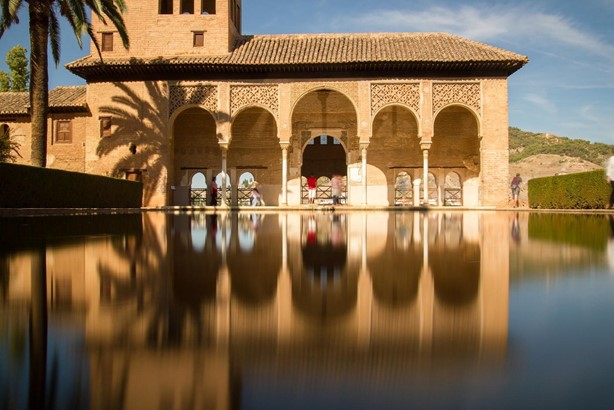
Surviving as the only palatine city, the Alhambra mirrors the Islamic Golden Age in Spain, in both Islamic architecture and Moorish aesthetics. The palace overlooks the city of Granada, with its gardens, orchids and fountains. The attribute which makes the place famous is the numerous legends and anecdotes attached to the castle’s history. This is truly one of the great palaces of Spain.
Visiting Alhambra Palace
If you are mesmerized by this architectural beauty and wish to visit the castle in person, the following are some of the tips that you should keep in mind before planning your visit.
- Make sure to reserve your ticket ahead of time, given the popularity of the palace with tourists.
- The standard ticketing price to visit Alhambra Palace is €14 ($16 USD).
- Make sure to visit the Nasrid Palaces first, before the gardens or Alcazaba fortress, since the entry time on your ticket is for the Nasrid Palaces.
Where to stay in Granada, Spain.
Cordoba Roman Bridge
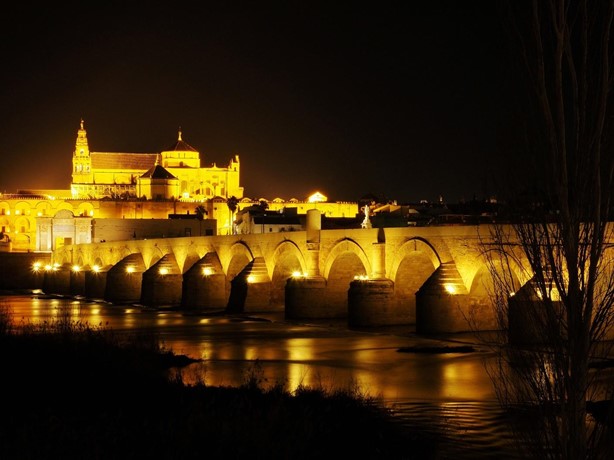
History of Cordoba Roman Bridge and Torre de la Calahorra
One of the most prestigious structures left in Spain by the Roman Empire, the Cordoba Roman Bridge was built in the 1st century BC. The bridge arches over the Guadalquivir River with a length of 247 meters (810 ft) and 9 meters (29.5 ft) in width. The original bridge built by Romans was made from wood, later solidified with bricks in the coming centuries. To the south of the bridge, a fortified tower known as Torre de la Calahorra was built around the 12th century by Almohad Caliphate.
Another tower to the north, also known as the ‘Gate of the Bridge’, was added 300 years later. St. Raphael Tower, to the eastern side of the bridge, was added around the 17th century. Cordoba Roman Bridge stood as a witness and facilitator to several wars fought in Cordoba throughout history.
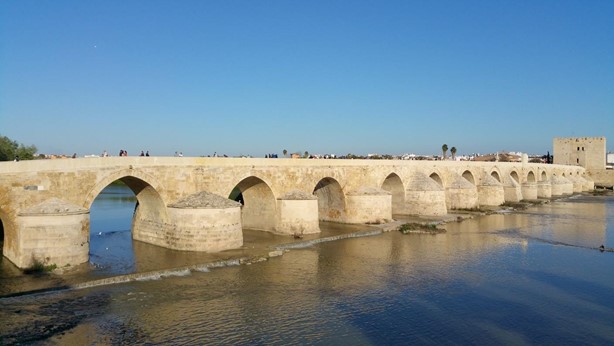
The bridge underwent several reconstructions and reinforcements throughout history. Today, the only original arches are at the northern end of the bridge built around the 14th and 15th centuries. The bridge holds immense popularity among tourists. It is a beauty to witness, especially around dusk and dawn. In contrast to the golden-red hues of the sky, the arches of the bridge add an unmatchable aesthetic for the beholder.
Visiting Cordoba Roman Bridge
If you are in the city and wish to visit the bridge in person, here are the following tips that will facilitate your trip to the Cordoba Roman Bridge.
- You can use public transport to get to the bridge. Bus numbers 03 and 12 leaving from Cordoba Central can take you straight to the bridge.
- The standard entry fee to visit the bridge is €4.50 ($5 USD) for adults and €3 ($3.5 USD) for senior citizens and students.
- If you wish to witness the bridge’s beauty at its peak, it is best to visit the bridge around dusk or dawn hours.
Accommodations in Cordoba, Spain.
Castle of Segovia
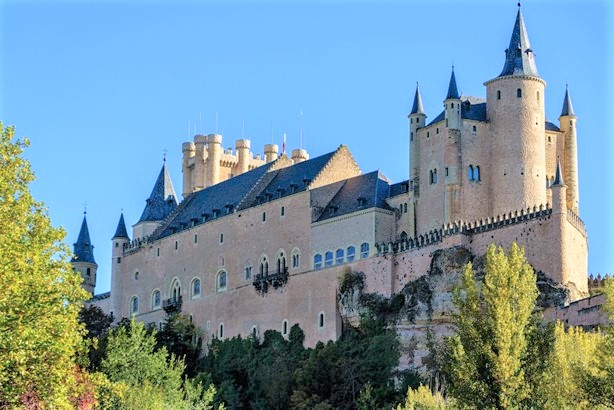
History of Segovia Castle
The inspiration for the Walt Disney logo, Castle of Segovia is a stone fortress from the 12th century built by Emperor Alphonso VI. The original foundation of the castle was established during Moorish rule when the castle was built to overlook the Iberian countryside. Later, the Catholics’ conquest was followed by Alfonso VIII’s marriage to Eleanor of England, and the King decided to convert the castle of Segovia into his residence.
After several phases of reconstruction and fortifications, the castle became the royal residence of Alphonso VIII. The gothic inspiration of the castle’s architecture was added during the reign of King Henry VI and John II. The castle enjoyed its glory as a military stronghold for its geostrategic location since it was built on the top of a granite cliff.
The next major reconstruction of the castle was done during the nineteenth century. The old interior of the castle was restored, followed by the deployment of the artillery corps, which still operate to date.
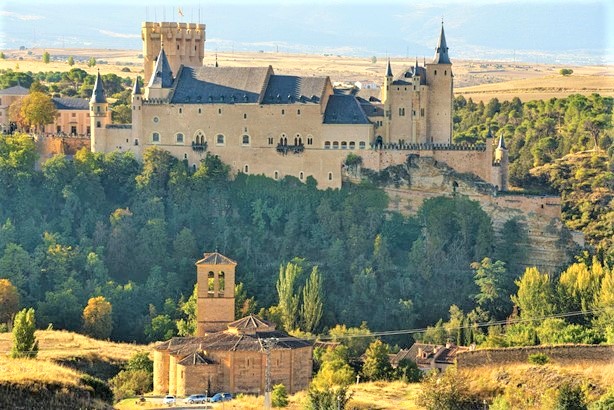
The castle today is a blend of archaic and modern renovations. The Flemish tapestries decorating the walls reflect architectural traditions from the 15th and 16th centuries, interwoven with Gothic and Mudéjar elements, a blending of architectural styles typical of castles and palaces of Spain. You will find the interior of the castle etched with the portraits and sculptures of the palace’s residents, in addition to a valuable collection of weapons from the archaic periods.
Visiting Segovia Castle
If you are looking forward to visiting this real-life Disney castle, we have you covered with some of the necessary tips and tricks that will facilitate your trip to the Castle of Segovia:
- It takes about an hour to reach the castle using a private vehicle, but if you are short on time, taking a train to the castle can cut your journey short by half an hour.
- You can buy two types of entry tickets: partial visit and full access to the castle. The ticket to get full access to the castle will cost €9 ($10 USD).
- It is best to buy a tour guide along with your visiting tickets so that you can easily navigate and explore the castle within the assigned time slot.
Best places to stay in Segovia, Spain
Coca Castle
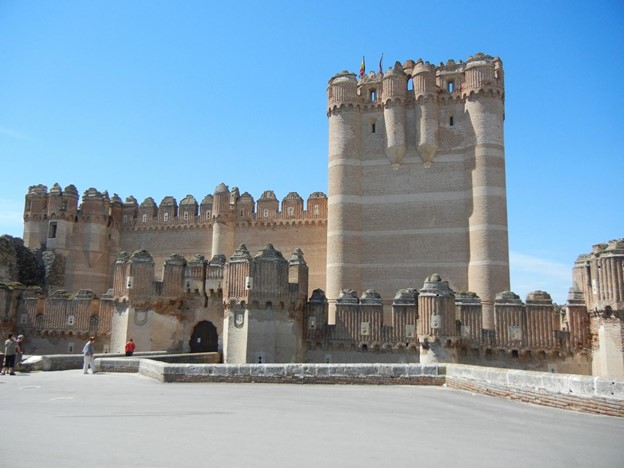
Another one of the historical marvels of Spain is Coca Castle (also known as Castillo de Coca). The architecture is unique among the castles and palaces of Spain. It is a massive stone fortification built by the Archbishop of Seville in 1453. The castle is believed to be the location originally known as Cauca, the birthplace of the Roman emperor Theodosius. The castle blends Western and Moorish architecture, common among the castles and palaces of Spain, including polygonal corners with double walls circled by a deep dry moat. The interior of the castle also features detailed decorations carved during the rule of the Moorish empire.
Despite its strong fortification and deep moat presenting a grave threat to any foreign invaders, the castle never saw any significant military action till it was conquered by Napoleonic French forces in 1808. The castle’s ownership was later transferred to the Alva family, where it became a training center for foresters.
Coca Castle today exists as a nationalized entity and is a Spanish National Monument. The nationalization of the castle, followed by its restoration, was done to dedicate the castle as a school for forestry. There are no significant interior decorations available to witness; however, the grand architecture of the castle itself compensates for the lack of material belongings inside.
Visiting Coca Castle
If you are aiming to visit this architectural beauty, the following are some of the necessary tips that will help you easily navigate your journey around Coca Castle:
- Using public transport to visit the castle is the cheapest and fastest method. The train ticket costs €21- €55 ($24-$65 USD) and can take up to four hours to reach the castle.
- The castle is sprawling with quite a bit of architecture to explore, so make sure to plan at least half a day to visit the whole castle.
Seville Cathedral and Alcazar
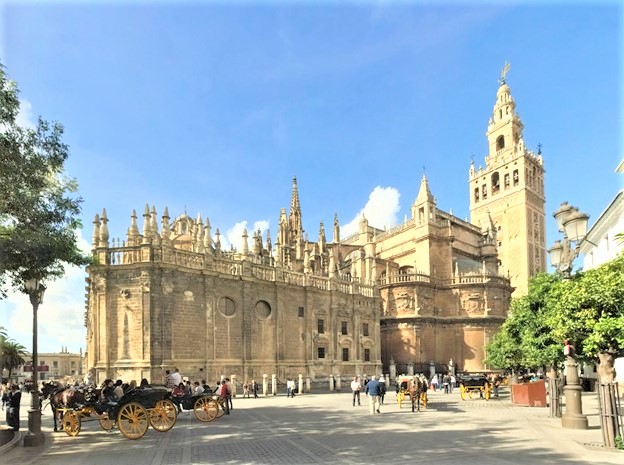
History of Seville Cathedral and Alcazar
The Seville Cathedral and Alcazar have been declared a joint UNESCO heritage. The castle was initially built on a ruined Roman fortress in the year 913 during the reign of Abd-Ar-Rahman III, the first caliph of Al-Andalus. The Abbadid dynasty later expanded the castle in the 11th century. With the conquest of the castle by King Alfonso X of Castile, the castle was further expanded, followed by the expansion of the Alcázar.
A cathedral to the Alcázar was also added around the 15th century. The mosque parallel to the castle was demolished, save a single minaret which became part of the cathedral. Seville Cathedral is an unparalleled historical marvel from its era with its high towers and architectural grandeur. It is considered the fourth largest cathedral globally; however, what makes this cathedral distinctive among others is the tomb-shaped structure located inside the cathedral.
The Seville Cathedral and Alcazár, both gems among the castles and palaces of Spain, stand in perfectly restored condition today, symbolizing the glory and grandeur of the past empires that the city witnessed. From the Courtyards of Maidens to the castle gardens to the detailed sketches and décor etched on the inside walls of the cathedral, both buildings narrate the story of past civilizations.
Visiting Seville Alcazar and Cathedral
- Since it is one of the tourist hotspots in Seville, it is best to reserve your tickets prior to visiting to avoid standing in long queues in hot temperatures.
- The standard ticket price to visit Alcazar Seville and the adjacent cathedral is €19 ($21 USD). For EU students and seniors above 65 years of age, the price is €9 ($10 USD), and for children, it is €1.2 ($1.35 USD).
- Visiting both the cathedral and the castle requires some time, so make sure to spare at least half of the day to fully appreciate the castle’s beauty.
Where to stay in Seville, Spain
If you love Spain, you’ll love these posts about Spanish culture, history and travel
- Explore the Regional Cuisine of Spain
- Hidden Gems in Spain
- 8 Off-The-Beaten-Track Adventures in Spain
- 2-Week Itinerary for Asturias: Northern Spain’s Paradise
- Best Places to Visit in Northern Spain: Asturias and Galicia
- Exploring Family Heritage in Asturias, Spain
- 16 Top Things to Do in Gran Canaria, Canary Islands, Spain
To best appreciate these architectural marvels, read up on their history first. Here are a couple of good reference books.
We hope you thoroughly enjoyed this journey to five intriguing historical castles and palaces in Spain. Let us know in the comments which of these glorious Spanish castles and palaces intrigued you the most or the one that you would like to visit in the future.
Author Bio: Elora Holt is a part-time personal assistant & freelance writer/editor. She is a full-time architecture geek, especially Gothic & Art Nouveau varieties – the quickest way to convince her to travel is to describe the architecture of the local (not that it will take much effort as she has a bucket list of locations that will take a lifetime). Elora is also a design geek, so her long-term focus is to work in 3D architectural rendering. But in the meantime, she’s enjoying grabbing a cup of coffee and writing about castles around Europe!

TO PINTEREST!

BTW, if you are getting ready for your trip, make sure to take advantage of these useful, money-saving links to book your trip:
- Research and book your flight with Skyscanner. I have found them to be the best because they list all airlines including the budget ones. You are always sure of having researched all options.
- For car rental around the world, Discover Cars has flexible pickup and drop-off options, I recommend Discover Cars.
- Book your accommodation with Booking.com. I find they have a wide selection and a nice, user-friendly, transparent website.
- Protect your trip and, more importantly, protect yourself with travel insurance. I use Travelinsurance.com and have been very happy with them.
- Looking for a small group tour to unforgettable destinations with top professionals? Intrepid Travel is your choice.
- For more general tours to any destination or attraction, book with Viator. Check them out.
- Need a visa? Get your visa for all countries with Passport Visa Express.
- Looking for a cool walking tour to explore a city? My favorite walking tours are offered by Take Walks.
- Food and drink tours are the best way to enjoy a city. And Devour Tours are my favorite.
- Looking for a good VPN to protect your security, privacy and freedom online while traveling? Nordvpn is your best option.
- The best and most economical way to stay connected while traveling is with an Airalo eSIM.
I personally use, and can recommend, all the companies listed here and elsewhere on my blog. By booking through these sites, the small commission we earn – at no cost to you – helps us maintain this site so we can continue to offer our readers valuable travel tips and advice.



















